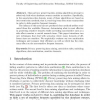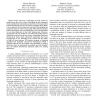311 search results - page 51 / 63 » Privacy-Preserving Data Imputation |
DAWAK
2006
Springer
13 years 11 months ago
2006
Springer
Many privacy preserving data mining algorithms attempt to selectively hide what database owners consider as sensitive. Specifically, in the association-rules domain, many of these ...
PVLDB
2010
13 years 5 months ago
2010
Random perturbation is a promising technique for privacy preserving data mining. It retains an original sensitive value with a certain probability and replaces it with a random va...
AUSDM
2006
Springer
13 years 11 months ago
2006
Springer
Data mining is playing an important role in decision making for business activities and governmental administration. Since many organizations or their divisions do not possess the...
ICDM
2008
IEEE
14 years 1 months ago
2008
IEEE
Many data sets are incomplete. For correct analysis of such data, one can either use algorithms that are designed to handle missing data or use imputation. Imputation has the bene...
BIBE
2007
IEEE
13 years 9 months ago
2007
IEEE
—DNA microarray technologies provide means for monitoring in the order of tens of thousands of gene expression levels quantitatively and simultaneously. However data generated in...


